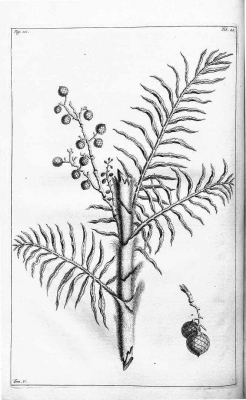Daemonorops calapparia
(Mart.) Blume
Arecaceae
It has been proposed - William J.Baker; A revised delimitation of the rattan genus Calamus (Arecaceae), Phytotaxa 197 (2): 139-152; 2015 - that the genera Ceratolobus, Daemonorops, Pogonotium and Retispatha should all be subsumed into a revised and expanded concept of the genus Calamus. This revised treatment has been accepted in the 'World Checklist of Selected Plant Families' and is likely to recieve further acceptance. For the time being, until there is wider acceptance of this change, we are not moving these species across into Calamus. The new name for this species in Calamus will be Calamus calapparius Mart. [
K- Title
- Plants for a Future
- Author
- Ken Fern
- Description
- Notes from observations, tasting etc at Plants For A Future and on field trips.
].
Calamus amboinensis Miq.
Calamus calapparius Mart.
Palmijuncus amboinensis (Miq.) Kuntze
Palmijuncus calapparius (Mart.) Kuntze
Common Name:
General Information
Daemonorops calapparia is a very large, evergreen, climbing palm with a cluster of long, unbranched stems that can grow to the tops of the trees in the rainforest.
The plant is harvested from the wild for its edible apical stems, which are consumed locally.
Known Hazards
None known
Botanical References
548- Title
- Annals of the Royal Botanic Garden Calcutta. Vol. 12, Pt. 1
- Publication
-
- Author
- Beccari O.
- Website
- http://www.biodiversitylibrary.org
- Publisher
- Bengal Secretariat Press; Calcutta.
- Year
- 1911
- ISBN
-
- Description
- A monograph of the genus Daemonorops. It can be downloaded from the Internet.
Range
Southeast Asia - Indonesia in the Moluccas.
Habitat
Not known
Properties
| Edibility Rating |      |
| Habit | Evergreen Climber |
| Height | 25.00 m |
| Cultivation Status | Wild |
Cultivation Details
Most species in this genus are more or less vigorous climbing plants in rainforests. In general, they are likely to grow best with their roots in the shade but with enough gap in the canopy to encourage their stems to grow up towards the light. They are also likely to grow best in a humus-rich soil[
K- Title
- Plants for a Future
- Author
- Ken Fern
- Description
- Notes from observations, tasting etc at Plants For A Future and on field trips.
].
A dioecious species, both male and female forms need to be grown if fruit and seed are required.
Edible Uses
The apical bud is cooked and eaten as a vegetable[
548- Title
- Annals of the Royal Botanic Garden Calcutta. Vol. 12, Pt. 1
- Publication
-
- Author
- Beccari O.
- Website
- http://www.biodiversitylibrary.org
- Publisher
- Bengal Secretariat Press; Calcutta.
- Year
- 1911
- ISBN
-
- Description
- A monograph of the genus Daemonorops. It can be downloaded from the Internet.
].
Medicinal
None known
Other Uses
The stems are of no value in basket making or weaving[
548- Title
- Annals of the Royal Botanic Garden Calcutta. Vol. 12, Pt. 1
- Publication
-
- Author
- Beccari O.
- Website
- http://www.biodiversitylibrary.org
- Publisher
- Bengal Secretariat Press; Calcutta.
- Year
- 1911
- ISBN
-
- Description
- A monograph of the genus Daemonorops. It can be downloaded from the Internet.
].
Propagation
Seed -
If you have any useful information about this plant, please leave a comment. Comments have to be approved before they are shown here.


 Useful Tropical Plants Database 2014 by
Ken Fern,
web interface by
Ajna Fern
with help from
Richard Morris.
Useful Tropical Plants Database 2014 by
Ken Fern,
web interface by
Ajna Fern
with help from
Richard Morris.